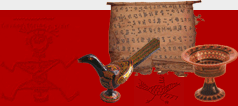|
毕摩文化及其保护与开发
Bimo Culture and Its Preservation and Development
木乃热哈 Munai Reha
中央民族大学中国少数民族语言文学学院语言文学系
【摘要】毕摩是彝族文化的集大成者和传播者,他们通晓彝族文献经籍、天文、地理、历算、医学、伦理、谱牒等。毕摩文化是彝族文化的重要组成部分。它以其独特的内容和形式,重要的社会功能和作用,在彝族文化的承保与发展进程中发挥着不可代替之作用。要使文化资源转化成为文化资本,同时又能保护毕摩文化的完整性,首先要对本土毕摩文化资源进行调查研究,确定好保护和抢救对象,在此基础上,合理开发利用好毕摩文化资源,尽力避免过度开发,而打破了彝族社区的文化生态的平衡性。唯其如此,才能促使文化资源向文化资本转变,充分发挥其资源优势,更好地和谐的彝族社区。
关键词: 彝族 毕摩文化 保护 开发
Abstract
Bimo is the master and carrier of Yi culture who commands
the traditional knowledge of Yi documents and sacred books,
calendar, computation, medical practice, lineages of family
trees and all the rituals etc. So the culture of Bimo is
an important part of the Yi traditional culture, which plays
an important role in the process of preservation and development
of the Yi culture for its rich contents, unique forms, and
its function in society. How to change the Bimo cultural
resources into cultural capital while keeping them intact?
The author believes the first thing to do is to conduct
an investigation of the local Bimo cultural resources, making
it clear which parts should be preserved and saved before
the development. Secondly, the resources should be reasonably
developed, avoiding over-developing; otherwise the balance
of the local cultural ecology will be broken.
Keywords: Yi people─bimo culture─preservation─development
作者简介:
木乃热哈,1982年毕业于西南民族学院彝语文专业,同年分到中央民族大学民语系从事彝语文教学,现为中央民族大学少数民族语言文学系副教授。1988年8月参加了在兰州举行的全国民族语文学术研讨会、1993年7月参加了在四川西昌举行的第一届国际藏缅语学术研讨会、1994年7月参加了在贵州毕节举行的四省区彝学研讨会、2001年9月参加了在云南石林举行的第三届国际彝学研讨会、2004年8月参加了在四川美姑县举行的彝族毕摩文化研讨会。先后在《民族语文》、《中央民族大学学报》、《民族教育研究》、《西南民族大学学报》等学术刊物上发表了有关彝族语言文化的学术论文20余篇。与人合著有《彝语词汇学》和《彝语基础教材》。
About the Author:
Munai Reha (Murlie Ssihxa), male, is an associate professor
in the Dept. of Linguistics of the Central University for
Nationalities. He has attended many academic conferences
and presented papers since 1988. He has published over 20
papers in Ethnic Languages, Journal of the Central University
for Nationalities, Ethnic Education Research, Journal of
Southwest University for Nationalities, and coauthored books
Yi Lexics and An Elementary Textbook of Yi Language.
|





